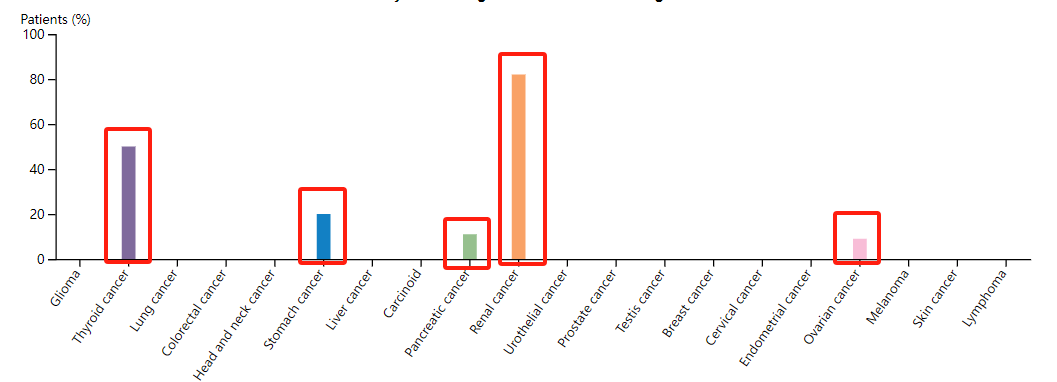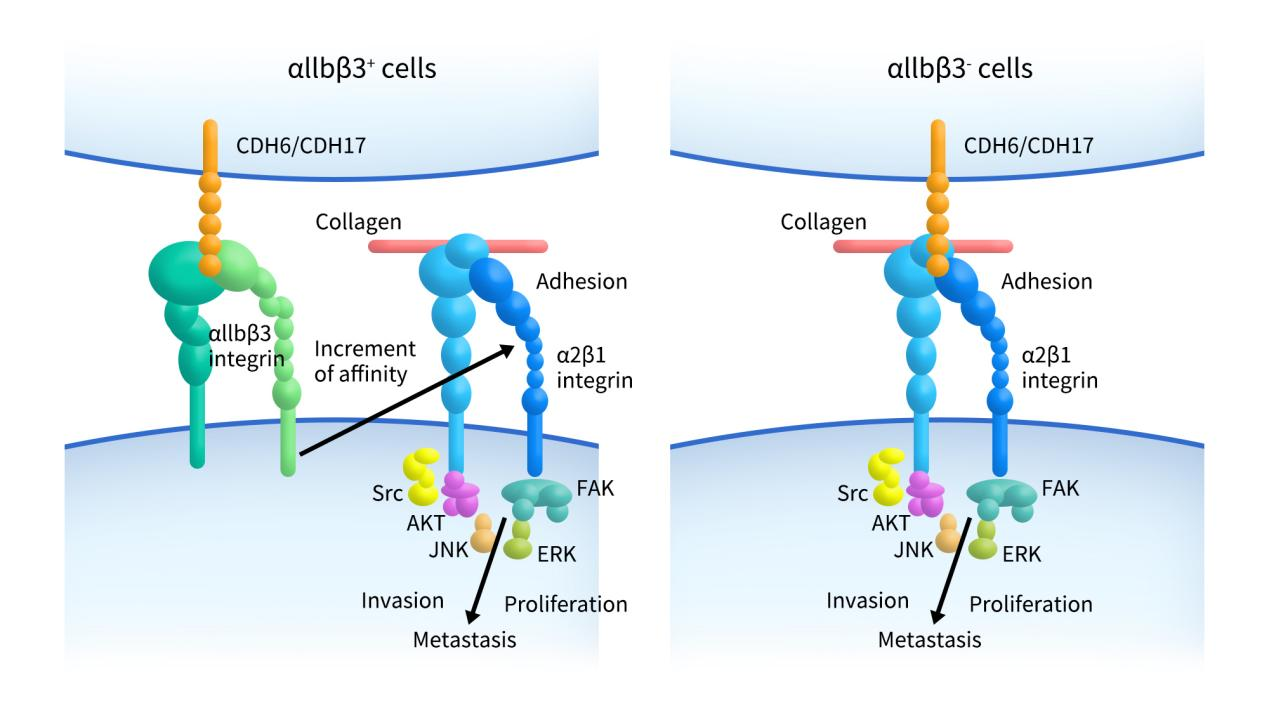In March 2024, a preclinical study titled “Raludotatug Deruxtecan, a CDH6-Targeting Antibody–Drug Conjugate with a DNA Topoisomerase I Inhibitor DXd, Is Efficacious in Human Ovarian and Kidney Cancer Models” was published in Molecular Cancer Therapeutics. This study demonstrated that Raludotatug Deruxtecan, developed by Daiichi Sankyo, is effective against human ovarian and kidney cancer models. Additionally, at the 2023 ESMO Congress, the results of a Phase I trial (NCT04707248) analyzing Raludotatug Deruxtecan as a monotherapy in previously treated ovarian cancer patients were presented. The subgroup analysis showed an objective response rate of 46% and a disease control rate of up to 98%. Considering the remarkable efficacy of CDH6, let’s delve into the background and current landscape of targeted therapies in this field.
1. CDH6 and Classic Cadherins
Cadherin 6 (CDH6), also known as fetal kidney cadherin or K-cadherin, is a single-pass transmembrane protein composed of 790 amino acids. It belongs to type II classic cadherins and is one of the members of the cadherin superfamily. The cadherin superfamily consists of four main subfamilies: classic cadherins, desmosomal cadherins, protocadherins, and atypical cadherins [1]. As shown in the figure below, classic cadherins are composed of three parts: an extracellular domain, a transmembrane domain, and a cytoplasmic domain. The extracellular domain contains five cadherin repeats (EC1-EC5). The extracellular structure, particularly the N-terminal domain (EC1), plays a crucial role in the homophilic recognition between cadherin molecules.
Classic cadherins are further classified into type I and type II based on whether the first EC domain contains the histidine-alanine-valine (HAV) motif. Type I cadherins consist of only five members: E-cadherin (CDH1), N-cadherin (CDH2), P-cadherin (CDH3), M-cadherin (CDH15), and R-cadherin (CDH4); CDH5-12, CDH18-20, CDH22, and CDH24 belong to type II cadherins. In addition to differences in the HAV motif, type I and type II cadherins also differ in certain amino acid residues. The conformation of cadherin molecules is stabilized only in the presence of Ca2+. The binding of Ca2+ to the extracellular portion of the peptide chain is a prerequisite for cadherin-mediated cell-cell adhesion. Calcium-binding sites, composed of short highly conserved amino acid sequences, are located between adjacent extracellular repeat sequences [2]. The cytoplasmic domain of classic cadherins can bind to p120-catenin and β-catenin, whereas other members of the cadherin superfamily (including protocadherins) do not bind to catenins.

Figure 1. The structure of classical Cadherin [3]
In humans, cadherin-6 is a protein encoded by the CDH6 gene (also known as CAD6 or KCAD), located on chromosome 5. Unlike other type II classic cadherins, CDH6 contains an RGD motif in the EC1 domain and an HAV motif in the EC5 domain, which are important for stabilizing and aggregating adjacent monomers. Similar to other classic cadherins, the cytoplasmic tail of CDH6 can bind to p120-catenin and β-catenin to regulate the actin cytoskeleton. Due to the central role of β-catenin in the Wnt signaling pathway, there is a link between β-catenin signaling and CDH6-mediated cell adhesion [4].
CDH6 is involved in the morphogenesis and development of the embryonic kidney and drives the mesenchymal-epithelial differentiation necessary for kidney morphogenesis. However, CDH6 expression is very weak in adult kidneys. In normal adult tissues, CDH6 expression is restricted to renal tubules, bile duct epithelial cells, and other areas. Additionally, CDH6 is also expressed in platelets, playing a functional role in platelet aggregation and thrombus formation. This function is mediated by the binding of the RGD motif to the αIIbβ3 integrin, which undergoes a conformational change and binds to fibrinogen, leading to platelet crosslinking [5].
2. CDH6 and Tumors
CDH6 is reported to be highly expressed in thyroid cancer, gastric cancer, pancreatic cancer, and ovarian cancer, with kidney cancer being the first cancer where high expression of CDH6 was observed.

Figure 2. The expression of CDH6 in various tumors (*Data derived from The Human Protein ATLAS)
The mechanism of CDH6’s role in cancer is not fully understood, but research by Rubén A. Bartolomé and colleagues indicates that CDH6 and associated integrins play a key role in the progression of ovarian and kidney cancers. As shown in the figure below, in cells with high expression of αIIbβ3, CDH6 preferentially binds to αIIbβ3, leading to the activation of α2β1 integrin. The activation of integrins promotes cell adhesion, invasion, and proliferation, resulting in the metastatic spread of cancer cells. In cells with low expression of αIIbβ3, CDH6 and CDH17 bind to α2β1 integrin, and this cadherin/integrin interaction promotes cell adhesion, migration, invasion, and proliferation by activating the SRC, FAK, AKT, and ERK pathways.

Figure 3. CDH6 and αIIb/α2 integrins are required for lung homing in ovarian and renal cancer[6]
3. Current Research Progress on CDH6 Targeted Therapy
CDH6 is frequently overexpressed in kidney and ovarian cancer patients, while its expression is limited in normal tissues, making it a promising target for developing targeted therapies. Currently, only three pharmaceutical companies are focused on CDH6, all working on CDH6 ADCs, but candidate products have already demonstrated significant potential.
- Raludotatug deruxtecan
Raludotatug deruxtecan, also known as DS-6000 or R-DXd, is an ADC targeting CDH6 developed by Daiichi Sankyo. R-DXd consists of a humanized CDH6 IgG1 monoclonal antibody, a cleavable linker, and DXd, utilizing Daiichi Sankyo’s signature combination of “GGFG peptide linker and DXd,” with a drug-to-antibody ratio (DAR) of 8. In February 2024, it received orphan drug designation from the EU for the indication of ovarian cancer. Early Phase I clinical trial (NCT04707248) results indicated that R-DXd as a monotherapy showed promising efficacy in patients with advanced ovarian cancer, with an overall response rate (ORR) of 46%, disease control rate (DCR) of 98%, and a median duration of response (mDoR) of 11.2 months. Currently, Daiichi Sankyo is collaborating with Merck to advance a Phase II/III clinical trial (NCT06161025) targeting platinum-resistant ovarian cancer patients.
- CUSP06
CUSP06, also known as AMT-707, is a CDH6 ADC developed by Multitude Therapeutics, Inc. It consists of three components: a proprietary antibody with high binding affinity for CDH6, a protease-cleavable linker, and an irinotecan payload (a TOP1 inhibitor), with a DAR of 8. The current development status is Phase I clinical trials (NCT06234423), targeting advanced malignant solid tumors and platinum-resistant ovarian cancer. In June 2022, Multitude Therapeutics reached a licensing agreement with OnCusp Therapeutics for the development and commercialization of AMT-707 (now referred to as CUSP06). According to the agreement, OnCusp Therapeutics will receive exclusive rights to develop and commercialize AMT-707 outside the Greater China region. Multitude Therapeutics will receive upfront payments, development, regulatory, and sales milestone payments, as well as tiered royalties.
Preclinical research data indicate that CUSP06 exhibits a stronger “bystander effect” compared to DXd-based CDH6 ADCs. CUSP06 selectively binds to cell surface CDH6 and is effectively internalized in CDH6-positive ovarian and kidney cancer cells. CUSP06 demonstrates potent anti-proliferative activity in various CDH6-positive cancer cell lines in vitro. Additionally, tumor regression has been observed in patient-derived xenograft (PDX) models with both low and high CDH6 expression following treatment with CUSP06 [7].
- HKT-288
HKT-288, also known as NOV-13, is a CDH6 ADC developed by Novartis Pharma AG. It consists of a fully human antibody selectively targeting CDH6, a cleavable linker (SPDB), and DM4. Currently, this drug has stalled in Phase I clinical trials. In the first-in-human study (NCT02947152), patients in the 0.75 mg/kg treatment group reported three cases of suspected related grade 2 neurological adverse events: one patient experienced seizures, while another had aphasia and encephalopathy. Further research could not determine the potential mechanisms behind the neurological adverse events, leading to the early termination of the study. Additionally, in the preclinical stage, there are bispecific antibodies being developed, such as ATG-106 (CD3 x CDH6) by Antengene Corporation Co., Ltd., and the CDH6 ADC BSI-709 developed by Biosion, Inc., although the BSI-709 project has been terminated. Furthermore, the monoclonal antibody CDH6-RGD developed by Protein Alternatives SL is still in the drug discovery phase.
4. DIMA Biotech’s CDH6-Related Products
Dima Biotech is a biotechnology company focused on preclinical development products and services for druggable targets. DIMA now offers a full range of products and services related to the CDH6 target. These products include active proteins, reference antibodies, and flow cytometry-validated monoclonal antibodies. The services cover customized antibody development across various species, antibody humanization, and affinity maturation. Additionally, to accelerate the development of CDH6-based therapies, Dima has established a CDH6 single B-cell seed bank, allowing for the generation of lead antibody molecules in as little as 28 days. Currently, we have screened 26 lead molecules for CDH6, all of which are cross-reactive with both human and monkey, with 25 also showing cross-reactivity with mice. Customers can receive these molecules the next day for functional evaluation. For some molecules, we are also conducting ADC internalization activity and cytotoxicity validations. Please feel free to inquire for specific data.
- CDH6 Protein&Antibody&Stable Cell Line&CDX SlideSet
| Product type | Cat. No. | Product Name |
| Recombinant Protein | PME101111 | Human CDH6 Protein, His Tag |
| PME-C100044 | Cynomolgus CDH6 Protein, His Tag | |
| PME-M100112 | Mouse CDH6 Protein, His Tag | |
| FC-validated Antibody | DMC100675 | Anti-CDH6 antibody(DMC675); IgG1 Chimeric mAb |
| Reference Antibody | BME100232 | Anti-CDH6(raludotatug biosimilar) mAb |
| BME100234 | Anti-CDH6(AMT-707 biosimilar) mAb | |
| Biotin-labeled Antibody | BME100232B | Biotinylated Anti-CDH6(raludotatug biosimilar) mAb |
| DMC100675B | Biotinylated Anti-CDH6 antibody(DMC675); IgG1 Chimeric mAb | |
| Stable Cell Line | CEL100055 | Hu_CDH6 CHO-S Cell Line |
| CDX SlideSet | SLI100004 | Balb/C nu HuH7 DiSliceX™ SlideSet |
- Progress on CDH6 Lead mAb Molecules

Reference:
[1]Brasch, J., Harrison, O. J., Honig, B., & Shapiro, L. Thinking outside the cell: how cadherins drive adhesion. Trends in cell biology, 2012, 22(6), 299–310.
[2]Ivanov DB, Philippova MP, Tkachuk VA. Structure and functions of classical cadherins. Biochemistry (Mosc). 2001, Oct;66(10):1174-86.
[3]Basu, R., Taylor, M. R., & Williams, M. E. (2015). The classic cadherins in synaptic specificity. Cell adhesion & migration, 9(3), 193–201.
[4]Stewart DB, Barth AI, Nelson WJ. Differential regulation of endogenous cadherin expression in Madin-Darby canine kidney cells by cell-cell adhesion and activation of beta -catenin signaling. J Biol Chem. 2000 Jul 7;275(27):20707-16.
[5]Casal, J. I., & Bartolomé, R. A. Beyond N-Cadherin, Relevance of Cadherins 5, 6 and 17 in Cancer Progression and Metastasis. International journal of molecular sciences,2019,20(13), 3373.
[6]Bartolomé, R. A., Robles, J., Martin-Regalado, Á., et al. CDH6-activated αIIbβ3 crosstalks with α2β1 to trigger cellular adhesion and invasion in metastatic ovarian and renal cancers. Molecular oncology, 2021, 15(7), 1849–1865.
Wei Lu, Jing Shi, Shu-Hui Liu, Nicole Covino, Xun Meng, Eric D. Slosberg. CUSP06/AMT-707, a new CDH6-targeting antibody-drug conjugate, demonstrates potent antitumor activity in preclinical models [abstract]. In: Proceedings of the American Association for Cancer Research Annual Meeting 2023; Part 1 (Regular and Invited Abstracts); 2023 Apr 14-19; Orlando, FL. Philadelphia (PA): AACR; Cancer Res 2023;83(7_Suppl):Abstract nr 6320.
